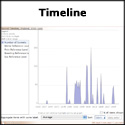The Sonnet Virus, 1555-1640
This project hopes to expose through modeling and visualization techniques, like IBM's ManyEyes and the Google Visualization API, new possible narratives for the rise and fall of the sonneteer in sixteenth-century England and beyond. New narratives take into account a variety of factors, including thematic and contextual issues, authorial personality, extra-generic appearances, gender, politics, and the very "technologies of reproduction" by which the sonneteer reproduced.
The Sixteenth-Century Sonnet
One of the most popular narratives explaining the English sonnet vogue relies on an understanding that then exemplary courtier, philospopher poet, and national hero, Sir Philip Sidney wrote a sonnet sequence, the rest of the country followed suit. The first sonnet of Philip Sidney's sonnet sequence Astrophil and Stella (pub. 1591) exemplifies not only the form, but the crucial themes of the sixteenth-century love sonnet (namely, a pining and self-obsessed lover with the metapoetical and futile hope that his writing can effect a return of his love from his virtuous beloved):
Loving in truth, and fain in verse my love to show,
That she (dear She) might take some pleasure of my pain:
Pleasure might cause her read, reading might make her know,
Knowledge might pity win, and pity grace obtain;
I sought fit words to paint the blackest face of woe,
Studying inventions fine, her wits to entertain:
Oft turning others' leaves, to see if thence would flow
Some fresh and fruitful showers upon my sun-burned brain.
But words came halting forth, wanting Invention's stay,
Invention, Nature's child, fled step-dame Study's blows,
And others' feet still seemed but strangers in my way.
Thus, great with child to speak, and helpless in my throes,
Biting my truant pen, beating myself for spite--
"Fool," said my Muse to me, "look in thy heart and write."



